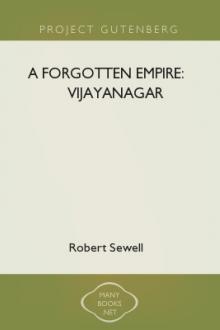A Forgotten Empire: Vijayanagar by Robert Sewell (short story to read TXT) 📕

- Author: Robert Sewell
- Performer: -
Book online «A Forgotten Empire: Vijayanagar by Robert Sewell (short story to read TXT) 📕». Author Robert Sewell
The decease of Bukka I. of Vijayanagar must apparently, for reasons shown, be placed at about A.D. 1379.
CHAPTER 4
Growth of the Empire (A.D. 1379 to 1406)
Harihara II. — Firuz Shah of Kulbarga — Fresh wars — Assassination of a prince in 1399 A.D. — Bukka II.
Bukka I. was succeeded by Harihara II., his son by his wife Gauri. Nuniz calls the new king “Pureoyre Deorao,” and “Pureoyre” seems to be a rough Portuguese version of the name Harihara; H and P representing the same sound in the Kanarese and Telugu languages. According to the inscriptions,[74] Harihara II. reigned at least twenty years, and he was the first king who gave himself imperial titles under the style of MAHARAJADHIRAJA. He gave many grants to the temples, and consolidated the supremacy of his dynasty over all Southern India. Sayana, brother of Madhavacharya, appears to have been his chief minister, as he was to King Samgama II.[75] Mudda is mentioned in two inscriptions of A.D. 1379 and 1382 as the king’s general. Another of his generals was called Iruga. He was son of Chaicha, minister of Bukka II. His name appears on a pillar in a Jain temple near Kamalapura at Vijayanagar in an inscription bearing date A.D. 1385; which proves that the king was tolerant in religious matters. There seems also to have been a general named Gunda living in his reign, but his date is uncertain.[76] According to another inscription,[77] King Harihara early in his reign expelled the Muhammadans from Goa; and the last inscription of his reign at present discovered78 mentions that one Bachanna Udaiyar was then governor of that place.
The king’s wife, or one of his principal wives, was Malladevi, or Mallambika. The extent of his domination is shown by the fact that inscriptions of his reign are found in Mysore, Dharwar, Conjeeveram, Chingleput, and Trichinopoly.[79] He was a worshipper of Siva under the form Virupaksha, but appears to have been singularly tolerant of other religions. The latest actual date of the reign afforded by inscriptions is October 15, A.D. 1399.[80]
Ghias-ud-din, a boy of seventeen, eldest son of the late Sultan Mahmud, had succeeded his father on the throne of Kulbarga; but on June 14, 1397,[81] he was treacherously blinded during an entertainment by an ambitious slave, after a reign of only one month and twenty days. His younger brother, Shams-ud-din, was then placed on the throne, but after a reign of five months was blinded and deposed by his cousin Firuz, second son of the late Sultan Daud. Firuz was by birth undoubtedly of the elder branch, and he became one of the most celebrated monarchs of his line, ascending the throne on November 15, A.D. 1397.[82] He must have then been well advanced in years, as Firishtah says he was “old” in A.D. 1419.
The date of the last inscription of Harihara II. as yet brought to light is, as before stated, October 15, A.D. 1399. There are two inscriptions extant of Bukka II., his eldest son, both dated in A.D. 1406,[83] and several of the latter’s successor, the younger brother of Bukka II., whose name was Devaraya I., and whose reign lasted till at least A.D. 1412.
It will be remembered that the first king of Vijayanagar, Harihara I., was an old man (Nuniz says “very old”), and reigned seven years. His successor, Bukka, his brother, reigned thirty-seven years according to Nuniz, and perhaps, therefore, it would be best not to assume too great an age for Harihara I. However this may be, it would appear that when the peaceful monarch Harihara II., son of Bukka I., came to the throne, his father must have died at a very advanced age, and he himself must have been by no means young. He reigned at least twenty years, as before stated, and we are therefore justified in assuming that at the close of his reign (in A.D. 1399) he was quite an old man. With this in our minds, let us turn to Firishtah’s narrative of the reign of Firuz Shah Bahmani, beginning with his accession in November A.D. 1397.
He tells us that in the Hijra year 801 (13th September 1398 to 3rd September 1399), month not given —
“Dewal Roy of Beejanuggur, with thirty thousand horse and a vast army of foot, invaded the royal territories between the rivers, with a design to reduce the forts of Mudkul and Roijore” (Raichur).
And in a later passage we are told that the campaign was at an end a few months before the end of Hijra 801; I.E. a few months before the end of August A.D. 1399. The first movement of the Hindu army must therefore have taken place at the beginning of the cold season of A.D. 1398, probably not earlier than December in that year, when the great cotton plains across which the troops had to march were passable. It can hardly be supposed that King Harihara II., then quite old and always a lover of peace, would without motive have waged this sudden war and himself led his armies into the field, and it seems more likely that the invasion was a bold dash made by his son with the king’s permission. The Muhammadan historians admit an unbroken peace of twenty years previous to this date.
It seems, therefore, that the chronicles of Nuniz, the writings of Firishtah, and the extant inscriptions all agree together, and that we must place the death of Harihara II. at the close of the year A.D. 1399. Little more can be said about the events of his reign.
The new king, his eldest son, Bukka II., must have been a man of middle age, as he had a son old enough to take the field with him before he himself came to the throne.
“This king (‘Pureoyre’),” says Nuniz, “had a son, who by his death inherited the kingdom, who was called Ajarao; and he reigned forty-three years, in which time he was always at war with the Moors.”
I can give no explanation as to why Nuniz calls the successor of Harihara II “Ajarao,” nor as to his estimate of forty-three years for his reign. The names and lengths of reigns given to “Ajarao’s” successors by our chronicler prove that by “Ajarao” he means two kings, Bukka II. and his successor, Deva Raya I.; and the period covered by their combined reigns was only fourteen years, not forty-three.
Nuniz states that the successor of Harihara II. greatly improved the city of Vijayanagar, raising fresh walls and towers, increasing its extent, and building further lines of fortification. But his great work was the construction of a huge dam in the Tungabhadra river, and the formation of an aqueduct fifteen miles long from the river into the city. If this be the same channel that to the present day supplies the fields which occupy so much of the site of the old city, it is a most extraordinary work. For several miles this channel is cut out of the solid rock at the base of the hills, and is one of the most remarkable irrigation works to be seen in India. No details are given of the wars he engaged in, except that, besides his campaigns against the Moors, he took “Goa, Chaul, and Dabull,” and reduced the Choromandel side of the peninsula to loyalty and obedience to his rule.
We learn a great deal more about the doings of Bukka II. and Deva Raya I. from Firishtah than from Nuniz, and I make no apology for quoting copiously from the former author, whose writings throw much light on the period.
Bukka’s first war began with the invasion already alluded to. It took place during his father Harihara’s reign, apparently about the month of December A.D. 1398 (rather later than earlier). The wide cotton plains of that tract are only passable during prolonged dry weather, and the prince would certainly not have risked an advance while there was any likelihood of rain falling. Bukka’s son accompanied his father, and the objective was the country of the Doab, and particularly the fortresses of Mudkal and Raichur, then in the hands of the Bahmani Sultan. Sultan Firuz moved to meet him, slaughtering on the way a Hindu chief or zamindar and seven or eight thousand of his followers, “who had always been very troublesome and refractory.” The Raya had advanced to the northern frontier of the debatable land and was encamped on the river Krishna, then in full flood, having large bodies of troops posted to oppose the passage of the Muhammadans.
“Sultan Feroze Shaw,[84] on his arrival near the river, held a council of war with his chief officers, but received no advice that to him appeared satisfactory.
“While the sultan was debating in his own mind how to act, Cauzi Serauje, seeing his concern, offered, if the sultan would permit him, to cross the river with a few of his friends, whom he would select for that purpose, to assassinate Dewal Roy or his son, as he found most convenient….
“The sultan approving the measure, some hundreds of hurdles covered with leather85 were prepared expeditiously for the troops to cross. Cauzi Serauje, with seven of his friends disguised as holy mendicants, proceeded to the roy’s camp, and repaired to the quarter where the dancing-girls resided.[86] Here the cauzi pretended to be enraptured with a courtesan, and was guilty of a thousand extravagances to support his character. In the evening the girl, having adorned herself in her richest ornaments, prepared to go out, on which the cauzi, like a jealous and distracted lover, falling at her feet, entreated her to stay, or let him attend her, and not rend his heart by her absence. The woman upon this informed him that she was ordered to attend an entertainment by the roy’s son, and durst not disobey, nor could she take him with her, as only musicians and dancers would be admitted. The cauzi upon this replied that he played on the same instrument as herself, and had, besides, some curious accomplishments that would highly please the roy’s son. The dancing-girl, thinking him in jest, out of contempt gave him her mundal,[87] and desired him to play, which he did in so masterly a manner that she was delighted, saying that his company would give her superiority over her fellows and do her honour with the roy’s son. Accordingly he with his companions attended the girl to the tents of the young roy.
“As is the custom of Dekkan, many sets of loolies88 and dancing-girls were ordered to perform at the same time, and having finished their parts, the roy’s son called for the players and mummers. The dancing-girl now obtained leave for the cauzi and one of his companions to show their feats. Having assumed the dress of women, they entered ogling and smiling, and so well imitated the mummers in playing on the mundal, dancing, and mimicry, that the roy’s son was charmed with their performances. At length they each drew a dagger, and, like the dancers of Dekkan, continued to flourish them for some time, making a thousand antic postures in advancing, retreating, and turning round. At last, suddenly rushing upon the roy’s son, they plunged both the daggers into his breast, afterwards attacking his companions. Their remaining friends, who were watching without the tent, on hearing an alarm, ripped up the curtain, and entered to assist them. Many of the company, being much intoxicated, were easily put to death. The cauzi with his friends extinguished all the lights, and, making their escape through the rent, mingled with the crowd. The outcry soon became general round the





Comments (0)